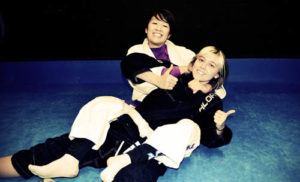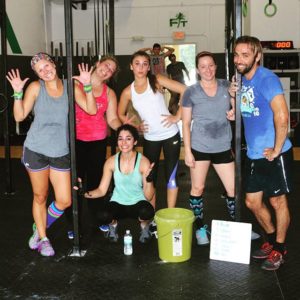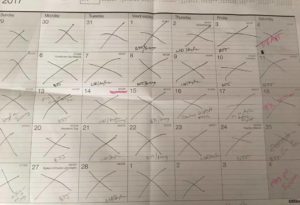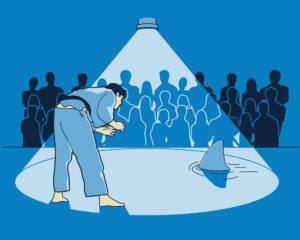All posts by Cecil Burch
Defending Against a Weapon Attack – A Visual Study
A couple of weeks ago, I was sent a video showing an older gentleman being attacked with a knife by a younger, bigger man. I am not 100% sure of the context, but from all appearances, it looked like the older person was a worker at a jewelry store that the younger man tries to rob. Take a look:
<>
There is a lot going on here. A number of my friends on Facebook talked about this video and made some comments that were repeated by different people. One of them, obviously, is how cool it was for the old dude to fight so hard. Rather than give up, he did everything he could to survive. We can all agree on that. One of the other comments though gave me pause. That comment generally followed the line of “he should have used the knife like x, y, or z to win the fight”. While that on the surface sounds good, it wildly misses the point. And that is what I want to cover in this article.
It is a crucial problem, yet one that comes up over again and people keep missing – that of the fixation on the tool to solve the problem. The knife is NOT the overwhelming problem at this moment. The overwhelming problem is that the defender has no control over the limbs of the bad guy. And so said limbs can do whatever it is they see fit to do – in this case, stab. The tool is just that, a tool. What is making it dangerous are the limbs powering it. Notice how the assault starts to change at the: 19 second mark. Why? Because the good guy manages to get a grasp on the knife arm, and the bad guy’s other arm is uselessly wrapped around the good guy’s head. Then notice the next major part at the 1:18 mark. The good guy now has the tool and gets in a couple of good thrusts. Why was he successful? Because his limbs were free due to the bad guy holding onto to a dumb headlock. Then, it changed again when the bad guy grabbed GG’s knife arm. Then comes a lengthy involvement where many of my friends talked about how if old tough dude just stabbed the right way, the fight would have turned out different. Sure, but why did he not use the knife well? Mostly because both people had essentially equal control over the other, but the BG was younger and bigger so he could negate much of the weapon use. That became even more apparent when the fight broke off and went to a slightly longer range where BG could actually move away and throw punches. When there is no dominant positional control, the fight goes to whoever has the superior attributes. Fortunately, BG decided that he was having too tough a transaction and got out leaving the older gentleman to seemingly be okay.
Now let’s look at a somewhat similar incident that turned out even better, and try to see why that was the case.
Similar circumstances – unarmed good guy versus knife wielding bad guy. Why though in the second video did the fight work out so well for the good guy? Yes, he started with catching the BG by surprise and hitting him with a chair, but it sure didn’t seem to have that much impact of the BG. So the chair from behind, while helpful, was not the main reason for the success. What was? Dominant positional control. Whether through design or luck, the GG managed to get to the bad guy’s back and stay there. He even put Mr. Knifer on the floor and put downwards pressure to keep him there, all of which made it nearly impossible for the knife to be used with any effect and was for all intents and purposes a very good way of controlling the bad guy’s attacking limbs.. All in all, an excellent example of positional dominance trumping the weapon. This is what we need to strive for in an entanglement with a weapon either in play, or there is a possibility of a weapon coming into play. Don’t overly fixate on the tool as the magic talisman that will solve all problems. Make sure it can’t be used first, then that you have freedom to do what you want to do, and only then does using a weapon yourself make any sense.
We do need to be mindful of what the weapon is doing and ensure that it is not being able to be used effectively against us, but the best, most reliable, and most consistent way to do that is control the position and the other person’s limbs. Do that and you go a long way to staying safe.
Emphasize The Fun!
Why don’t more people actively train in self-defense oriented activities?
This is something that many people in the training community have been talking a lot about. Karl Rehn of KR Training wrote a fascinating study (check the first part out here: http://blog.krtraining.com/beyond-the-one-percent-part-1/ ) where he looked at how many people who took the time to get a Texas concealed carry permit then followed up with more training. His estimate, based on a ton of sources and data, was that one percent (1%) goes on to do either other training, or shoot in organized competitions. That is simply stunning, especially considering the popular notion that Texans are all carrying guns and go shooting all the time. Other experienced trainers such as Tom Givens of Rangemaster have said similar things based on how much they travel around and conduct coursework.
It is probable that more people train in some form of martial art with the express purpose of self-defense (after all, that is the main role of martial arts traditionally), but even then, the numbers are not huge. It is rare to see any kind of martial art school have more than a couple of hundred students at the maximum.
And we all know of most of our family or friends who join a fitness gym every January 1st, only to quit soon after.
So what is the problem? Why aren’t more people joining in and becoming more capable and more dangerous? While there are probably a number of reasons, I strongly feel one of the biggest is a perceived lack of fun and enjoyment.
Face it. One of the reasons we are apt to do certain things is that there is a component of fun. Having fun creates a positive feedback loop that keeps us coming back for more. If a task is drudgery, even if it is seen as beneficial to us, there is little incentive to jump into it with full vigor and focus. Pretty much anyone who smokes knows it is bad for you, but trying to quit is sheer misery for almost everyone. That is why there is such a high recidivism rate. We need to enjoy on some level the process we are in.
Unfortunately, the training community tends to sell the value of training as “you will get kilt in da streetz if you don’t take xxxx training course!” or “your family will die a horrible death from a criminal predator if you don’t carry your Callahan Fullbore Autolock (nerd reference!)!” I myself have been guilty of this as well. None of us are immune. But we need to move away from Einstein’s definition of insanity – doing the same thing over and over and expecting a different result. If we are only reaching 1% of the population, then we are doing it wrong.
In my weekly classes I teach, one of the things that sold most of the new people who signed up was seeing how much fun the other students were having. The prospective person saw a large group working really hard at choking each other out, but also saw how big the smiles were on both parties face. Why would you not want to join in on something so obviously joyful? Once that lesson sunk in enough times with me, I realized that is a good avenue to pursue.
Let us go out and show everyone that when we are on the BJJ mats, in the weight room, on the shooting range, or doing a demanding training course like Craig Douglas’ ECQC or Mike Pannone’s Covert Pistol Carry, that regardless of outcome, we are having a great time! Put up pictures of people laughing and smiling, even if they are dirty and bedraggled and obviously worn out. That is what will help reach the rest of the public and convince them it is a good idea to step into this world. Not one more picture of some tatted up, bearded dude all decked out in Crye and showing off how cool he feels with that weapon in his hand. Or that example of that Guru trainer who thinks he has all the answers and anyone who dares thinks otherwise is a wuss.
Don’t present the image of the warrior at war with the universe, but the average person having a good time while working to become more capable, more dangerous, and just a general all around better person. That is what will make those “outside our world” pay attention. Don’t scare them, or berate them, but show them this lifestyle is just plain rocking fun!
The Counting Game

One of the buzz terms in the self-defense/tactical communities is “situational awareness”. Everyone, from instructors on down to the newest students talk about it and emphasize that it is one of the most important things we can have going for us to keep us safe. No one in their right mind will argue this. The problem is how we put it into practice?
Seriously, this is one of the biggest issues we face. Awareness is not a verb, yet we treat it like it is. How do we ensure that we are aware when we need to be? It is all well and good to tell someone to be aware and switched on, but that is like saying “be a good shooter”. How do we accomplish that task?
A number of top instructors spend time on this and there are different takes, most of which are valid and functional. I would like to present one that has proven to be really useful for me, as well as a number of people who I have taught it to, including members of my immediate family. It is an easy way to build the habit of situational awareness, and it does so by keeping us alert in the most vulnerable times in our life.
I call it the Counting Game. The way it works is this: every time you leave a building – any kind of building, from your place of work, to a grocery store, bank, restaurant, etc. – you need to count how many people you see. That’s it. Just count them up. It takes only a few seconds, at most, and even then that would only be on occasion, such as leaving the shopping mall during the Christmas season. Most of the time it is the work of one to two seconds at best. Easy to do, and easy to remember, and it does not take any special training. We are not asking you to see the potential bad guys, or judge actions. Just count.
So what does that give us? Multiple things. For one, we immediately know who is around us, fulfilling part of Givens’ Law (who is around us and what are they doing?). Second, by making sure we actually count, we have to pay attention to what is beyond our head and keeps us from burying our nose in a Smartphone or something similar that puts blinders on us. Third, it tells potential bad guys who are doing their own scan that we are paying attention and have seen them, even momentarily. That is one of the biggest ways to get yourself deselected as a victim. Bad guys prefer if they can get close without notice first. Being seen by the victim from across the parking lot is not good for business, especially when there are plenty of people behind you who will not be paying attention. And fourth, it starts to let our subconscious start to make thin-slicing judgments of what we have seen – i.e. “That guy was standing back by that wall in partial darkness. Why?” (Allowing that instinctive part of our brains to continue to listen to Givens’ Law). Which further helps being aware of the situation and the general environment. And all done with a simple mental exercise that only costs a couple of seconds of focus. Not a bad return on the investment.
Give it a shot. I think you will be pleasantly surprised how easy it is to add to your daily routine
Training Planner Trick
One quick and easy method that has helped me immeasurably over the years is the use of a desk calendar. I am talking about the big type that you can get from any of the big office supply stores. Here is a sample of one of mine from a few months ago.
This is how I use it. I look ahead at the next two weeks. I know what my current general needs in training are and I jot down what I want/need to do over that time. I know what kind of time crunch my life and schedule puts on me, so I try to be as realistic as possible and I never write down some idealized plan. It is always what I can actually do with a little focus and effort.
If you look at the picture above, you can see my focus was on BJJ, boxing (including standing clinch and weapons work), dryfire, and my LSD (long, steady distance) cardio block. The weather was awesome so it was great to run at night when the temperature was about 75 degrees, so I went heavy on that and put my strength or metabolic work programs on hold. I also tried to get some live fire time in. I try to do either one competition (the local USPSA club runs a terrific Thursday night fun shoot – semi-outlaw and geared to welcoming new shooters. It is perfect to get some solid work in), a shooting course, or just a trip to the range to get some rounds downrange. I co-hosted Craig Douglas for his fantastic Vehicle Combatives and Shooting Tactics course, so I was guaranteed some live fire there. Anything else in the month was going to be a bonus.
I scribble down at the beginning of the week what I want to do for the next two. Then I can use that to guide me and keep it fresh in my head what is coming up. What I found to be too typical if I did not do this would be that during the day something would come up – tough or long day at the office, poor sleep the night before, something up family wise – and I would forget the plan for the day. When you realize that you forgot only when you are getting into bed at 11:30 at night, it is generally too late. With this method, I could keep an idea every morning what I needed to do and that gave me time to try to implement it, regardless of what popped up.
Take a look at the February 17 as a perfect example. I was flying out that day to teach in central Texas. I would be at work for a couple of hours, then leave for the airport, fly there, then rent a car and drive another hour and a half to my destination. I was not going to get to the hotel before 10PM. And then I would have to prep for teaching the next day. So if I just stumbled my way through, there was a fairly decent chance I would forget about getting any training in until too late. Using the calendar reminded me to not let that happen. So when I got to work in the morning, I saw that and I grabbed my SIRT pistol (which I use in my seminars) and got in a couple of minutes of presentation and trigger press. Was it a lot? Not at all, but it was a lot more than I would have most likely gotten in if I had not already made the reminder.
Hopefully this gives you one more tool to help get in as much training as you want.
Finding A Good BJJ School
I get the question a lot on how to find a good school to train at. I have addressed it a number of times here and variopus places online, but it is a continuing issue for new people just getting into the art. Stephen Kesting of Grapplearts ( http://www.grapplearts.com/ )just posted up a good video that I agree heavily with. Check it out:
Be Gray

There is a common saying in the tactical training and self-defense communites: Don’t be prey; be a predator.
At first glance, that is a really cool thought. Don’t we all want to have a mental self-construct of being capable and powerful (especially if it is so obvious to outside observers that we can frighten off potential attackers)? Of course!
There is an underlying problem there though that all too often gets short shrift in the community. Without a doubt, none of us want to look like prey. That is all too readily apparent. But do we truly want to look like a predator?
Before you answer yes, think about this. In the wild, if you are a predator, are you immune to attack? Obviously not. So who is attacking? Other predators! And sometimes, that other predator may be the apex predator of the area. For example, when a young lion wanders into new territory already occupied by another lion, the resident lion is not going to let that pass. He will want to keep his food supplies to himself, as well as his access to his sexual partners. The same holds true in the world of Violent Criminal Actors (VCA). They too want to maintain their control; of the resources and sexual partners, as well as having the added need to maintain “respect”. And the VCA will not act as the animal in the wild does. He will not obviously challenge his new rival. Far from it. The VCA will do whatever it takes to maintain his dominance. If that means sucker punching, or hitting from behind, or bringing a gun to a fist fight, or even bringing friends, he will do so. He will do whatever he can do to keep his apex predator spot.
And to make this situation worse, we may not even know that we are challenging some thug. We may have our situational awareness switched on, but this type of thing may not help us if the other guy sets up an ambush dedicated to taking us out.
So if we don’t want to be prey, and being a predator may put us directly in the line of fire, what do we do? The third path. Being the Gray Man (or woman).
Anyone who has been smart enough to take any of William April’s coursework will understand that criminals have a very simple binary decision tree to do their violence. It is go or no-go. There is no “maybe” in the process. If you look like someone they can rob or assault, they do it. If you look like anything but an easy day, they won’t. It sounds simple, but it is true. They want to do what they need to do to get paid, and they are not interested in a fight. If they look at you and go “I don’t know”, their instantaneous decision to a definite no. That is what the real world research tells us, over and over. So we can use that knowledge and understanding.
If we don’t conduct ourselves like a victim, we won’t be victimized. Walk like you know what you are doing and where you going, pay attention to those around you (Given’s Law – Who is around me, and what are they doing?), don’t be ostentatious in dress or in things you have displayed on you, and you will negate almost all threat from the opportunistic criminal. On the flip side, do not walk around acting like you think you are the hardest hardcase on the planet, don’t mean mug every person you meet, and don’t wear sleeveless t-shirts that are three sizes too small, and you now remove yourself as looking like a predator on the prowl and other predators ignore you.
With simple, easy to implement steps, we make our lives massively safer and more peaceful. Win!
As much as I love the training I have done over the past 38 years of learning to fight, shoot, and be fit, I much prefer to not have to exercise those skills unless they are in a training environment. Life is too short to be occupied with violence.
Be the Gray Man, and have a fun life.
Building Shark Habits
We have discussed previously on many occasions the difficulties in training for the Multidisciplinary practitioner paradigm. We have so many components and (most of us) have so little free time that it often becomes a herculean effort to make sure we are doing the things we need to do. We have to figure out how each of us can best go about building good functional performance across the areas that we know are important. I have written previously about some ideas on how to do so:
http://www.iacombatives.com/2017/05/19/re-post-training-priority-for-a-modern-lifestyle/
http://www.iacombatives.com/2017/05/01/fitness-self-defense-and-bjj/
http://www.iacombatives.com/2016/11/07/a-pathway-to-competency/
http://www.iacombatives.com/2012/08/09/71/
http://www.iacombatives.com/2016/08/19/super-secret-tip-to-become-the-ultimate-ninjakung-fu-master/
Here is a series of YouTube videos where I discuss other methods and tricks :
https://www.youtube.com/playlist?list=PLG28VL9OG9c4buRGhkU8tsahrI5MmdWGJ
https://www.youtube.com/playlist?list=PLG28VL9OG9c4g5G5Ra1o0QLjExwaRjqpo
So as you can see, I talk about this subject a lot, because I know from firsthand experience how much effort it takes to accomplish our goal. I would like to add another way to get a step further along the pathway. Be a Shark.
What do I mean by this? It is something I read in an article by S&C coach extraordinaire Dan John. He talked about having a shark habit of taking a bite out of something that makes an impact. In other words, when a shark takes a bite out of a meal, it is not a small nibble; He commits to something big and immediately is on his way to having a good dinner. Dan John writes about the same approach to training (in his case, strength, conditioning, and diet). Rather than trying to do a bunch of little things, focus on something that can be done in a smaller package. For example, with the multi-disciplinary approach, maybe we make an effort to get good medical training to handle the emergencies that can come up in life. About 98% of the things we will ever be able to handle without hospital support can be learned in the basic one day Red Cross First Aid/CPR class, and a single one or two day “tac med” course. Then a bit of practice, and maybe take a refresher course every other year, and you will have that box easily checked off.
Or another, get a good introductory defensive pistol class (not a typical CCW class, but a full one day in depth class) and then take a weekend class with an experienced instructor who has taught a lot of folks like a Tom Givens. Those, along with some dry fire, some range work every now and then, as well as maybe a few competitions a year will cover almost every conceivable need with a pistol for self-defense.
In other words, we take a committed shark bite out of something specific and hyper-focused that will get us a good return.
We can also take Mr. John’s analogy a bit further. What other aspect of a shark is so obvious? How about the fact he is particularly single minded. He does not dither and lollygag. He wakes up and decides the most important thing to do is eat. He will then go after food until done. Nothing else gets in the way. We can use that idea as well.
Here is how we can implement that. Let’s say you are starting grappling, or wish to, and want to get in whatever work outside of class you are able to do. Rather than jump in and try to think you are going to practice 2 hours a night, and within two days you have already failed, let’s do it in smaller chunks. Here is my assignment for you: For one minute every day, you will do hip lifts and hip escapes solo (for tips, I have some videos on how to perform those movements on my YouTube channel). You will do that EVERY SINGLE DAY FOR AN ENTIRE MONTH. Don’t worry about any other training activity. If you have time to do other stuff, or just more of the solo grappling work, than fine. But don’t focus or even plan on it. All I want you to do is one single minute of non-stop work for one month. If for some reason you miss a day, don’t worry about it. Just start the countdown all over. No big deal. We all have those moments. Once you have gone an entire month doing this without missing a day, THEN AND ONLY THEN will we add to the program.
When you have knocked the first month out, we can add more time, or a different piece of the puzzle. Say, pistol dry fire. But again, we are going for the bite size chunk, not trying to down the entire sea lion with one gulp. Whatever you add, make it realistic and doable.
We will continue this for a total of three months, adding one piece each month. At the end of three months of daily work, you need to stop, take a breath, and pat yourself on the back, because you have done a damn fine job of building new habits that you can continue for the rest of your life. Be proud, but don’t get lazy! Get back on the job, and keep building. The beautiful thing is that after three months, you will start to see some results, and you will also start to see how you can integrate more and more parts of the paradigm that you can add without any prompting from me. Which is what a good coach should do – give you the ability to think for yourself.
Now I know some people reading this will react with “but three months? I want to be a bad ass now!”. My question is, what are you doing to do it? If you have not done it already, what does it matter that it is not an immediate solution? At the very least, you are on the path, and taking solid steps. That is what is important. Not how fast you get it done. Start building shark habits and do work!
New Interview
A short interview I did this past weekend where we manged to get in a bunch of info, including what I think an instructor should be doing to get better, my main underlying principle when I teach a seminar, and who else you should train with.
New Seminar – Chapel Hill, NC 11/4-5/2017
I will be teaching my fundamental Immediate Action Jiu-Jitsu and Immediate Action Pugilistic Coursework in Chapel Hill, NC on November 4-5th, 2017. This will be set up as two individual days – one day will cover surviving on the ground (IAJJ), and the other day will standing striking and clinch (IAP). Patrons can attend one or both days as they wish. There will also be the option to attend either morning only if you are time constrained.
Cost will be $150/person for one day, or $250 if you sign up for both. If you want to attend the morning only of either day, that will be $100.
Saturday will be the ground focused day and it will run from 1PM- 9:30PM. Sunday will be the standing day, and it will run from 9AM-5:30 pm.
The location will be:
https://www.chapelhilljiujitsu.net/
To register, contact Mike Levandoski at :
See below for coursework description and requirements:
Immediate Action Jiu-jitsu
Real World Application of Brazilian Jiu-Jitsu in a Weapon-Based-Environment
Contrary to popular belief, many empty hand fights and those involving weapons, end up on the ground. No amount of pontificating or self-proclaimed “expert“ posturing will change this simple fact. If you ignore this reality, you may very well find yourself in a situation you cannot handle with disastrous consequences. This course is designed to give the layman a realistic and functional set of concepts, techniques, methodologies, training drills and experiences that will prepare them for a worst case “ground-fight” scenario. All techniques and concepts are high percentile applications, which span a wide spectrum of confrontations. Training consists of presentation, drilling and Force-On-Force evolutions providing attendees with immediate feedback regarding the efficacy of the skills learned. The goal of this course is not to create a “ground fighter” or grappler. The objective is to provide attendees who have limited training time and resources with solid ground survival and escape fundamentals geared toward the increasingly violent weapon based environments they may live, work and/or travel within. And all techniques/concepts are from Brazilian Jiu-Jitsu and are combat proven over the past 80 years by thousands of practitioners, including the U.S. Army.
•These methods are for everyone regardless of physical condition – young, old, male, female, athlete or not – You DO NOT have to be a professional fighter to perform at a functional level. This will be a class about physical training, but it is NOT boot camp. Participants may go at the pace that is comfortable for them, while trying to push the envelope of their own individual performance.
•Requirements: Loose, comfortable but durable clothes, mouthpiece, knee pads, elbow pads, cup, notebook, and an open mind
The course is divided into modules that address specific situations. Seminars/training can be customized to fit your needs by arranging for the appropriate modules to be covered. Among the topics covered by the modules include:
Surviving/defending/escaping when you are on the ground underneath an attacker
Surviving/defending/escaping when you are on the ground and your opponent is standing
Functional methods of getting back to your feet
Countering takedowns and remaining on your feet
IFWA (in-fight weapon access)
Denying your opponent’s weapon access – understanding technique, positional hierarchy AND timing
Multiple opponents – realistically maximizing your chances
Surviving inside the guard
Proper usage of the guard to win/escape
Defending against punches, elbow strikes, stomps, kicks, etc…
Proper role of “dirty tactics”
Essential training principles, methods, & drills
How these concepts & techniques remain true with or without weapon involvement
Learning to deal with the most common MMA attacks and holds
Recognizing and defending against common submissions (guillotine, rear naked choke, triangle, arm bar, etc.)
Structuring and balancing your training and integrating it into a busy real world lifestyle
Immediate Action Pugilism
Boxing for Self-Preservation in the Weapons Based Environment
Sometimes, in order to defend our loved ones, and ourselves the only tool we might have to rely on is our own body. Even if you have external weapons, you might not be able to access them. Your safety may come down to how well you can survive a hand-to-hand confrontation. The Immediate Action Pugilism course is designed to give the layman a realistic and functional set of concepts, techniques, methodologies, training drills and experiences that will prepare them for a worst case H2H scenario. All techniques and concepts are high percentile applications, which span a wide spectrum of confrontations. Training consists of presentation, drilling and Force-On-Force evolutions providing attendees with immediate feedback regarding the efficacy of the skills learned. The goal of this course is not to create a professional boxer or MMA competitor. The objective is to provide attendees who have limited training time and resources with solid fundamentals geared toward the increasingly violent weapon based environments they may live, work and/or travel within.
All the techniques presented are based on orthodox and MMA boxing methods and are the best, most functional and high percentage moves and tactics available.
.
• These methods are for everyone regardless of physical condition – young, old, male, female, athlete or not – You DO NOT have to be a professional fighter to perform at a functional level. This will be a class about physical training, but it is NOT boot camp. Participants may go at the pace that is comfortable for them, while trying to push the envelope of their own individual performance.
• Requirements: Boxing gloves (at least 12oz or bigger unless per-authorized by the instructor), loose, comfortable but durable clothes, mouthpiece, cup, notebook, and an open mind. MMA gloves are strongly encouraged, but are not mandatory.
Immediate Action Pugilism is divided into modules that address specific situations. Seminars/training can be customized to fit your needs by arranging for the appropriate modules to be covered. Among the topics covered by the modules include:
Why & How to use Boxing in a WBE
Underlying Concepts and Mindset for useDealing with the Sucker Punch / Ambush
The Default Cover Transitioning to and Regaining the Initiative1st stage of defense – the fighting platform2nd stage of defense – arm motion, footwork, level change
1st stages of offense – jab & cross; proper method of delivering impact safely
Secondary Striking Tools (Eye Jab, Elbow, Knee, Slap,)Fundamentals of the Clinch/Safely Entering
Controlling the Entanglement Individual & Partner Drills.
Gradual introduction and immersion into sparring.
Fighting at Close Quarters; attached and unattached striking.
Disengaging from the clinch.
Safely gaining distance for escape, weapons access, or orientation reset.
Keeping the Fight standing, realistically defending the takedown.
Performance Coaching and Troubleshooting; Insights and Suggestions for Solo Training.
Tips and pointers on how to train the material with the limitations of a real world lifestyle.





